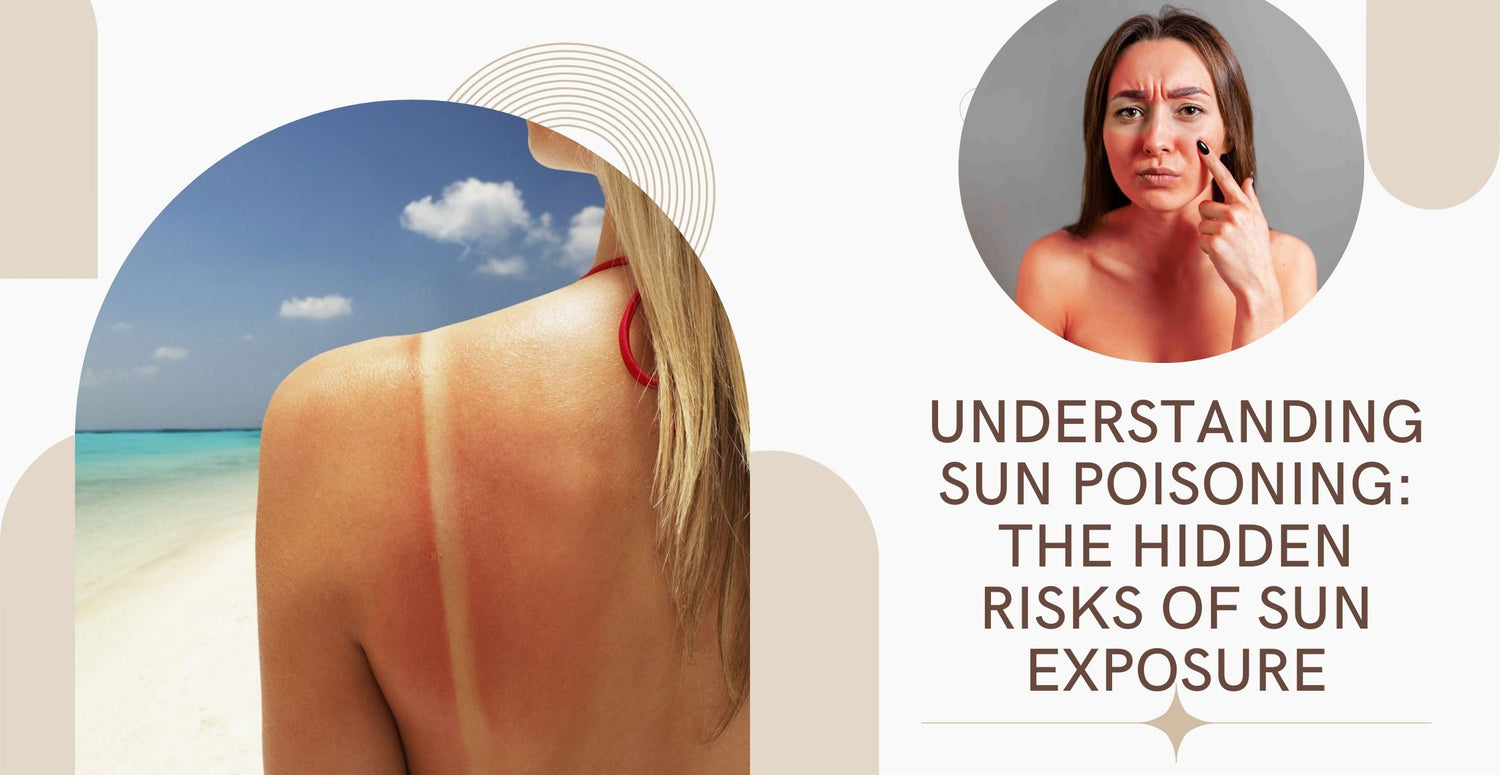Sun poisoning, also known as severe sunburn or photodermatitis, is a severe skin reaction resulting from prolonged or intense sun exposure. While sun poisoning is similar to sunburn, it has more severe symptoms and may necessitate medical treatment. This blog explains everything you need to know about the hidden risks of sun exposure and sun poisoning.
Identifying Sun Poisoning: Symptoms and Immediate Actions
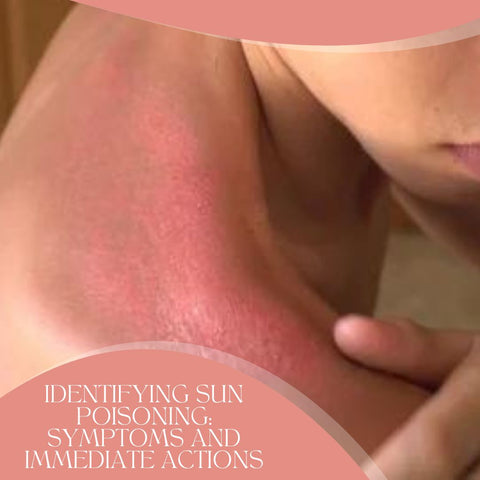
Early detection of sun poisoning is critical for effective treatment and symptom management. Here are some common symptoms to look for and immediate steps to take if you suspect sun poisoning:
Symptoms of Sun Poisoning:
-
Sunburn is more widespread and painful than usual, affecting many areas of the body.
-
Intense skin redness, swelling, and inflammation are frequently accompanied by warmth and pain.
-
Blisters or large, fluid-filled bumps appear on the skin and can rupture and ooze fluid.
-
Severe itching, pain, or discomfort in the affected areas, makes it difficult to touch or move.
-
Some people may develop headaches, dizziness, nausea, or vomiting as a result of sun exposure.
-
In severe cases, sun poisoning can cause fever, chills, dehydration, and other systemic symptoms.
Immediate Actions:
-
Move to a shaded or indoor location to avoid further sun exposure and the risk of worsening symptoms.
-
Apply cool, damp compresses to the affected skin to help relieve inflammation, pain, and discomfort.
-
Drink plenty of water to stay hydrated and replenish fluids lost during sun exposure. Dehydration can exacerbate symptoms of sun poisoning.
-
Take over-the-counter pain relievers like ibuprofen or acetaminophen to alleviate pain, inflammation, and fever. Follow the dosage instructions on the package.
-
Avoid scratching or picking at blisters because it increases the risk of infection and slows healing. To avoid skin irritation and rubbing, wear loose-fitting clothing.
-
If you have severe sun poisoning symptoms, such as extensive blistering, fever, nausea, vomiting, or dehydration, seek medical attention right away. A healthcare professional can offer appropriate treatment and advice based on the severity of your symptoms.
The Early Signs of Sun Poisoning: What to Look Out For
Recognising the early signs of sun poisoning is critical for taking immediate action to avoid worsening symptoms. Here are some early indicators to look out for:
-
The affected skin may be red or pink, indicating the early stages of sunburn. This redness may appear mild at first, but it can quickly worsen with continued sun exposure.
-
Increased blood flow and inflammation may cause the affected area of the skin to feel warmer than the surrounding areas.
-
The skin may be tender to the touch, particularly in areas where sun exposure has been prolonged or intense.
-
In the early stages of sunburn or sun poisoning, the skin may feel itchy or uncomfortable.
-
Some individuals may experience mild swelling of the affected skin, particularly in areas that have been exposed to direct sunlight.
-
Feeling fatigued after sun exposure can be an early sign of sun poisoning. This may be accompanied by a mild headache or malaise.
-
A slight headache or feeling of pressure in the head may develop due to sun exposure, especially if dehydration occurs.
If you notice any of these early signs of sun poisoning, you should take immediate action to avoid further sun exposure and relieve symptoms. Move to a shaded or indoor area, apply cool compresses to the affected skin, drink plenty of water to stay hydrated, and use over-the-counter pain relievers if necessary. If symptoms worsen or persist, seek medical attention right away for further evaluation and treatment.
First Aid for Sun Poisoning: Steps to Mitigate the Harm
If you suspect sun poisoning, you must take immediate action to reduce the damage and symptoms. Get out of the sun, use cool compresses, hydrate, use over-the-counter pain relievers, apply aloe vera gel, avoid further irritation, rest and recover, and monitor symptoms. If the symptoms of sun poisoning are severe or persist despite home treatment, seek medical attention immediately. A healthcare professional can provide additional evaluation, treatment, and guidance based on your specific needs.
When Sun Exposure Turns Dangerous: Recognizing Heat Exhaustion
Recognising heat exhaustion is critical for taking early action to avoid heat-related complications. Here are some common signs and symptoms to look for:
-
Heat exhaustion is characterised by profuse sweating as the body attempts to cool itself. However, in some cases, sweating may suddenly stop.
-
Feeling weak, tired, or exhausted despite minimal physical activity is a common early indicator of heat exhaustion.
-
You may experience dizziness or lightheadedness, particularly when standing up or moving quickly. This may increase the likelihood of falls or accidents.
-
Dehydration and overheating can cause throbbing headaches.
-
Heat exhaustion can cause nausea or vomiting, especially if you are dehydrated.
-
Due to decreased blood flow and sweating, the skin may feel pale, cool, and clammy.
-
Dehydration and electrolyte imbalances can cause painful muscle cramps, particularly in the legs, arms, and abdomen.
-
Your heart rate may rise to keep blood flowing to vital organs and compensate for dehydration.
-
In severe cases, heat exhaustion can cause fainting and loss of consciousness. This calls for immediate medical attention.
Strategies for Prevention and Protection
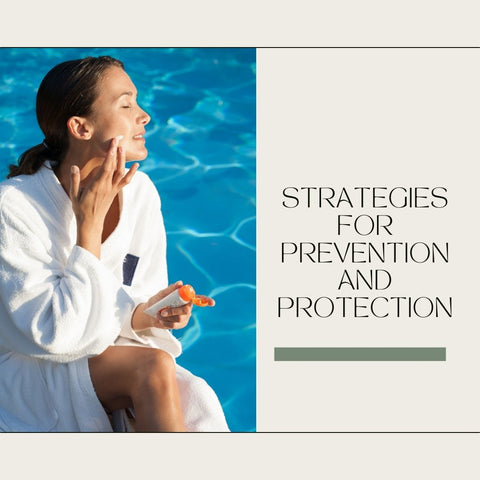
Preventing heat-related illnesses such as heat exhaustion entails taking proactive steps to protect yourself from prolonged heat exposure. Stay hydrated, limit outdoor activities, wear appropriate clothing, apply sunscreen, seek shade, use cooling measures, monitor vulnerable individuals, acclimatise to heat, know the signs of heat-related illnesses, and stay informed. By implementing these prevention and protection strategies, you can reduce your risk of heat-related illnesses while remaining safe and comfortable during hot weather.
Sunscreen Mastery: Choosing the Right Protection
Choosing the right sunscreen is crucial for effective sun protection. Here are some key factors to consider when selecting a sunscreen:
-
Look for a sunscreen that offers broad-spectrum protection, which means it protects against both UVA and UVB rays. UVA rays can prematurely age the skin, while UVB rays cause sunburn.
-
Choose a sunscreen with an SPF of 30 or higher for adequate protection. SPF 30 blocks about 97% of UVB rays, while higher SPFs offer slightly more protection but no sunscreen can block 100% of UV rays.
-
If you'll be swimming or sweating, opt for a water-resistant sunscreen. Water-resistant sunscreens protect for either 40 minutes or 80 minutes of water exposure, as indicated on the label. Remember to reapply after swimming or sweating.
-
Consider your skin type and any sensitivities you may have when selecting a sunscreen. If you have sensitive skin, choose a sunscreen that is hypoallergenic and free of fragrances, dyes, and other potential irritants.
-
Sunscreens come in various formulations, including lotions, creams, gels, sprays, and sticks. Choose a formulation that suits your preferences and needs. Creams and lotions are often preferred for dry skin, while gels and sprays may be more suitable for oily or acne-prone skin.
-
Sunscreens contain active ingredients that provide sun protection. Mineral sunscreens contain zinc oxide or titanium dioxide, which physically block UV rays from penetrating the skin. Chemical sunscreens contain organic compounds that absorb and dissipate UV radiation.
-
Consider the ease of application when choosing a sunscreen. Some people prefer spray sunscreens for quick and convenient application, while others prefer lotions or sticks for more precise coverage.
-
Check the expiration date on the sunscreen before use. Expired sunscreen may be less effective at protecting against UV rays. Additionally, sunscreen should be replaced annually for optimal protection.
-
Consider the reputation of the sunscreen brand and read reviews from other users to gauge its effectiveness, texture, and overall performance.
-
Follow the usage recommendations on the sunscreen label for optimal protection. Apply sunscreen generously to all exposed skin areas, and reapply every two hours or more frequently if swimming or sweating.
Dressing for Sun Safety: The Role of Protective Clothing
Protective clothing is essential for sun safety because it provides an extra layer of protection against harmful UV radiation. Here's how to effectively select and wear protective clothing like UPF clothing, dark, tight-knit fabrics, long-sleeved shirts and pants, wide-brimmed hats, sunglasses, UV-Protective clothing, moisture-wicking fabrics, layering, UV-Protective swimwear and cover-up accessories. Protective clothing can help you avoid sunburn, premature ageing, and skin cancer by limiting your exposure to the sun.
Beyond the Sunscreen: Hydration and Antioxidant Defense
In addition to sunscreen and protective clothing, hydration and antioxidant defence are essential for skin health and sun protection. Here's how to include hydration and antioxidants in your sun protection regimen:
-
Drink plenty of water throughout the day to keep your skin hydrated from the inside out. Dehydrated skin is more susceptible to sun damage and may be more prone to sunburn and irritation. Aim to drink at least eight glasses of water per day, and more if you're spending time outdoors in the sun.
-
Use a hydrating moisturizer to keep your skin moisturized and nourished. Moisturizers help replenish lost moisture, strengthen the skin barrier, and prevent dryness and irritation. Look for moisturizers with ingredients like hyaluronic acid, glycerin, or ceramides for added hydration.
-
Incorporate antioxidant-rich skincare products into your routine to help protect your skin from free radical damage caused by UV radiation. Antioxidants neutralize free radicals and reduce oxidative stress, which can lead to premature aging and skin damage. Look for skincare products containing antioxidants such as vitamin C, vitamin E, green tea extract, or niacinamide.
-
Maintain a balanced diet rich in antioxidants to support skin health from the inside out. Include foods like fruits, vegetables, nuts, seeds, and whole grains, which are high in vitamins, minerals, and phytonutrients with antioxidant properties. Berries, leafy greens, citrus fruits, and nuts are particularly rich in antioxidants.
-
If you're not getting enough antioxidants from your diet, consider taking antioxidant supplements to support skin health and provide additional protection against sun damage. Talk to your healthcare provider before starting any new supplements to ensure they're safe and appropriate for you.
-
Apply antioxidant serums containing potent antioxidants like vitamin C or vitamin E to your skin before sunscreen application. These serums help boost the effectiveness of your sunscreen and provide added protection against UV-induced free radical damage.
-
After spending time in the sun, replenish your skin with antioxidant-rich products to help repair and protect against sun damage. Look for after-sun lotions or serums containing soothing ingredients like aloe vera, cucumber extract, or chamomile, along with antioxidants to support skin recovery.
Managing the Aftermath: Treatment and Long-Term Care
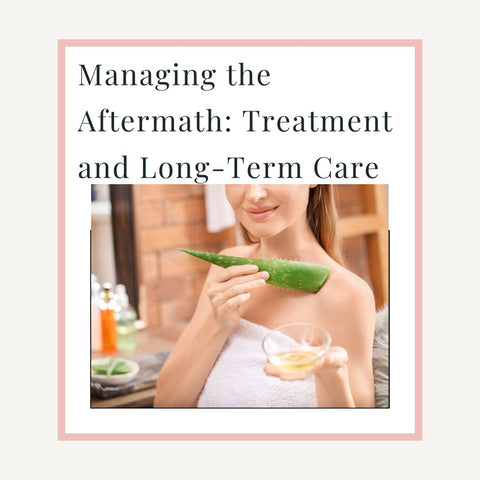
Managing the aftermath of sun exposure entails immediate and long-term care to treat any sunburn or sun damage and prevent further damage. Here are some tips for dealing with the aftermath of sun exposure, including cool compresses, moisturising, hydrating, over-the-counter pain relief, avoiding further sun exposure, topical treatments, antioxidant serums, long-term sun protection, regular moisturization, and skin checks. By following these treatment and long-term care strategies, you can effectively manage the effects of sun exposure, promote skin healing, and avoid future sun damage and complications.
Home Remedies for Sun Poisoning: Effective Natural Solutions
While medical treatment is often required for severe cases of sun poisoning, some home remedies can help alleviate symptoms and promote skin healing. Here are some effective natural solutions for treating sun poisoning:
-
Aloe Vera: Apply pure aloe vera gel directly to sunburned skin to soothe inflammation, reduce redness, and promote healing. Aloe vera has cooling and moisturizing properties that can provide relief from sunburn and sun poisoning.
-
Cool Compresses: Place cool, damp washcloths or towels on sunburned areas to help reduce heat and inflammation. Avoid using ice directly on the skin, as it can cause further damage.
-
Oatmeal Bath: Add colloidal oatmeal to a cool bath and soak for 15-20 minutes to soothe sunburned skin and relieve itching and inflammation. Oatmeal has anti-inflammatory properties that can help calm irritated skin.
-
Apple Cider Vinegar: Dilute apple cider vinegar with water and apply it to sunburned skin using a cotton ball or soft cloth. Apple cider vinegar has anti-inflammatory properties that can help reduce pain and redness associated with sunburn.
-
Green Tea: Brew green tea, allow it to cool, and apply it to sunburned skin using a cotton ball or spray bottle. Green tea contains antioxidants and anti-inflammatory compounds that can help soothe sunburn and promote healing.
-
Coconut Oil: Apply pure coconut oil to sunburned skin to moisturize and soothe inflammation. Coconut oil has antimicrobial and anti-inflammatory properties that can help reduce redness and prevent infection.
-
Vitamin E Oil: Break open a vitamin E capsule and apply the oil directly to sunburned skin to promote healing and reduce inflammation. Vitamin E is a powerful antioxidant that can help repair damaged skin cells.
-
Honey: Apply raw honey to sunburned skin to moisturize, soothe inflammation, and promote healing. Honey has antibacterial and anti-inflammatory properties that can help reduce pain and prevent infection.
-
Cucumber: Place chilled cucumber slices or cucumber puree on sunburned skin to help cool and hydrate the skin. Cucumber has anti-inflammatory properties that can help reduce swelling and discomfort.
-
Stay Hydrated: Drink plenty of water to stay hydrated and help your body recover from sun poisoning. Proper hydration supports skin healing and can help prevent dehydration associated with sunburn.
Medical Intervention: Knowing When to Seek Help
While home remedies can help with mild cases of sun poisoning, it's important to know when medical attention is required. Severe pain, extensive blistering, fever, nausea and vomiting, headache and confusion, signs of infection, difficulty breathing, weakness or fatigue, skin peeling, and pre-existing health conditions are all indications that you should seek medical attention for sun poisoning. If you have any of these symptoms or are unsure whether your sunburn requires medical attention, err on the side of caution and consult a healthcare professional. They can offer appropriate treatment and advice based on the severity of your symptoms and your personal health status.
Healing and Recovery: Replenishing Your Skin Post-Sun Poisoning
After sun exposure, it is critical to focus on healing and replenishing your skin to promote recovery and prevent further damage. Here are some steps to replenish your skin after sun poisoning:
-
Drink plenty of water to replenish your body and promote skin healing from the inside out. Proper hydration replenishes lost fluids and promotes skin recovery.
-
Moisturise sunburned skin with a soothing, hydrating moisturiser to replenish moisture and repair the skin barrier. Look for moisturisers that contain soothing and hydrating ingredients such as aloe vera, hyaluronic acid, or ceramides.
-
Cool compresses and baths can help soothe sunburned skin and reduce inflammation. Ice should not be applied directly to sensitive skin because it can cause further damage.
-
Apply pure aloe vera gel to sunburned skin to relieve inflammation, reduce redness, and promote healing. Aloe vera has cooling and moisturising properties that can help relieve sunburn.
-
To repair sun-damaged skin and protect it from further damage, use antioxidant-rich serums containing ingredients such as vitamin C or vitamin E. Antioxidants help to neutralise free radicals and reduce the oxidative stress caused by UV radiation.
-
Exfoliants, alcohol-based products, and fragrances are all examples of harsh or irritating skincare ingredients to avoid sunburned skin. These can aggravate sensitive skin and delay healing.
-
Gently cleanse sunburned skin with a mild, non-irritating cleanser to remove dirt, sweat, and sunscreen residue without aggravating the skin.
-
Cover sunburned areas with lightweight, breathable clothing to prevent further sun exposure and irritation. Wear loose-fitting clothing made of soft, natural fabrics such as cotton to reduce friction and discomfort.
-
To protect sunburned skin from further sun exposure, stay indoors or seek shade whenever possible. If you must go outside, wear protective clothing, hats, and sunglasses, and apply sunscreen to any unaffected areas.
-
Allow your skin to heal and recover by avoiding excessive sun exposure and letting it rest. Avoid strenuous activities that may further irritate sunburned skin and prioritize rest and relaxation.
Towards a Sun-Safe Future: Awareness and Education
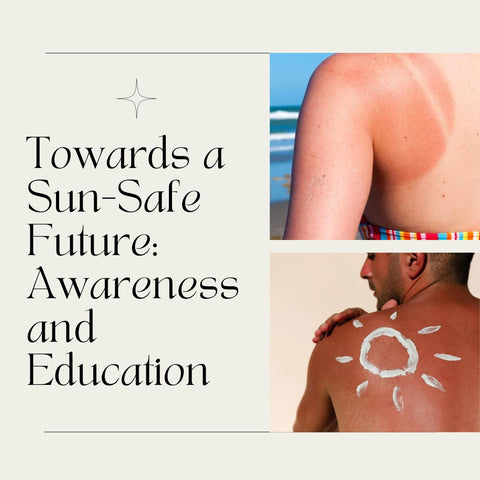
Raising awareness and education about sun safety are critical steps towards a sun-safe future. Individuals and communities can help to raise awareness and knowledge about sun protection through educational campaigns, school programmes, community outreach, healthcare providers, media and social media, sun safety policies, role modelling, support research, community partnerships, and regular screenings. Individuals and communities can empower themselves to make informed decisions about sun protection by raising awareness and education about sun safety.
Dispelling Myths: Understanding the True Impact of Sun Exposure
Dispelling myths and understanding the true impact of sun exposure are critical for promoting sun safety and avoiding sun-related skin damage and health problems. Here are some common myths about sun exposure and the facts that will dispel them:
-
Myth 1: Sunscreen is only needed on sunny days. Fact: Even on cloudy or overcast days, UV radiation can reach through clouds and cause sunburn and skin damage. It's essential to wear sunscreen every day, regardless of the weather.
-
Myth 2: You cannot get sunburned through glass. Fact: Although glass can block UVB rays, UVA rays can still penetrate and cause skin damage over time. It is critical to protect your skin from sun exposure, even indoors or in vehicles.
-
Myth 3: Dark-skinned people do not require sunscreen. Fact: Although darker skin tones have more natural UV radiation protection, they are still susceptible to sunburn, skin damage, and skin cancer. Everyone, regardless of skin colour, should wear sunscreen and practise sun safety.
-
Myth 4: Base tans protect against sunburns. Fact: Base tans provide little sunburn protection and do not prevent skin damage or cancer. Any tan indicates skin damage, and long-term sun exposure raises the risk of skin cancer.
-
Myth 5: Sunscreen is sufficient for sun protection. Fact: While sunscreen is an important part of sun protection, it should be used in conjunction with other sun safety measures like wearing protective clothing, hats, and sunglasses, seeking shade, and avoiding peak sun hours.
-
Myth 6: Sunburn is only harmful if it blisters. Fact: Even mild sunburns can cause long-term skin damage and increase the risk of developing skin cancer. Protecting your skin from sunburn and practicing sun safety are critical for reducing the risk of skin damage and health issues.
-
Myth 7: Sun exposure is required for vitamin D synthesis. Fact: Although sunlight is a primary source of vitamin D, excessive sun exposure can cause sunburn, skin damage, and cancer. It is critical to balance sun exposure with sun safety precautions and obtain vitamin D through diet and supplements as needed.
-
Myth 8: Sunscreen with a high SPF offers all-day protection. Fact: Regardless of SPF, sunscreen should be reapplied every two hours, or more frequently if swimming, sweating, or towel drying. No sunscreen provides 100% protection, and regular reapplication is essential for effective sun protection.
Empowering Prevention: Educational Strategies for All Ages
Educational strategies promoting sun safety should be tailored to different age groups and populations to effectively empower prevention. Here are some educational strategies for promoting sun safety among all ages:
For Children:
-
Incorporate sun safety education into the school curriculum through interactive lessons, activities, and assemblies. Teach children the value of sunscreen, protective clothing, and seeking shade when outdoors.
-
Encourage teachers and school staff to model sun-safe behaviours by wearing hats, sunglasses, and sunscreen when they are outside with students. Set a good example and reinforce sun safety habits.
-
Implement sun safety policies for outdoor activities, such as mandating hats, sunscreen application, and shaded rest areas during playtime and outdoor sporting events.
-
Provide children with educational materials such as colouring books, storybooks, and posters that teach sun safety concepts enjoyably and engagingly.
For Adolescents and Teens:
-
Engage adolescents and teens as peer educators to raise sun safety awareness among their peers. Encourage them to launch sun safety campaigns, events, or clubs in their schools or communities.
-
Use social media platforms to share sun safety tips, facts, and challenges geared towards adolescents and teens. Use hashtags, videos, and infographics to make sun safety messages more relatable and shareable.
-
Collaborate with sports teams, coaches, and athletic associations to promote sun safety at outdoor practices and competitions. Provide sun safety resources at sporting events such as sunscreen stations and educational materials.
-
Educate adolescents and teenagers about the dangers of indoor tanning and the link between sunburn and skin cancer. Encourage them to make informed decisions regarding tanning beds and sun exposure.
For Adults:
-
Incorporate sun safety into workplace wellness programmes by providing educational materials, sunscreen samples, and encouraging sun-safe practices during outdoor work activities.
-
Organise sun safety workshops or seminars for adults in community centres, libraries, or healthcare settings. Discuss topics like proper sunscreen application, skin cancer prevention, and regular skin checks.
-
Educate parents about the importance of sun safety for their children, as well as tips for preventing sunburn and skin damage. Provide resources like brochures, newsletters, and online resources.
-
Attend health fairs, community events, and farmer's markets to distribute sun safety materials, provide sunscreen samples, and perform skin cancer screenings or consultations.
By implementing these educational strategies, we can empower people of all ages to practise sun-safe behaviours, reduce their risk of sunburn and skin cancer, and enjoy outdoor activities while protecting their skin.
The Importance of After-Sun Care: Preserving Skin Health Long-Term
After-sun care is essential for maintaining skin health over time and minimising the effects of sun damage. Here's why after-sun care is important and how it helps to maintain long-term skin health:
-
After-sun care soothes sunburned skin and relieves the pain, inflammation, and discomfort caused by prolonged sun exposure. Soothing ingredients like aloe vera, chamomile, and cucumber can help calm irritated skin and promote healing.
-
Sunburn can deplete the skin's moisture levels, causing dryness, tightness, and flakiness. After-sun products with hydrating ingredients like hyaluronic acid, glycerin, and ceramides replenish moisture and restore the skin's natural barrier function.
-
Sunburn causes an inflammatory response in the skin, which can result in redness, swelling, and sensitivity. After-sun products with anti-inflammatory ingredients such as green tea extract, oatmeal, and vitamin E help to reduce inflammation and soothe the skin.
-
Prolonged sun exposure can damage the skin's DNA, resulting in premature ageing, wrinkles, and a higher risk of skin cancer. After-sun care products containing antioxidants such as vitamin C, vitamin E, and resveratrol help to repair and protect the skin from further damage by neutralising free radicals and reducing oxidative stress.
-
Sunburned skin tends to peel as it heals. After-sun products with moisturising ingredients help to prevent excessive peeling by keeping the skin hydrated and promoting a smoother, more even texture.
-
Consistent after-sun care contributes to overall skin health and resilience, reducing the long-term effects of sun damage and promoting a more youthful, radiant complexion. By caring for your skin after sun exposure, you can reduce the risk of premature ageing and maintain a healthy skin barrier.
-
Proper after-sun care entails avoiding further sun exposure and engaging in sun-safe behaviours to prevent further skin damage. This includes wearing protective clothing, hats, sunglasses, and applying sunscreen regularly when outdoors.
-
After-sun care offers an opportunity to educate people about the importance of sun safety, such as wearing sunscreen, seeking shade, and avoiding peak sun hours. By promoting sun-safe behaviors, we can reduce the risk of sunburn and long-term skin damage.
Embracing a Holistic Approach to Sun Safety: Building a Healthier Relationship with the Sun

Taking a holistic approach to sun safety entails developing a healthier relationship with the sun that considers physical, mental, and emotional well-being. Here are some tips for developing a holistic approach to sun safety, including understanding sun exposure, respect for nature, mindful sun exposure, sun-safe behaviours, nourishing your body, hydration and self-care, embracing diversity, regular skin checks, a balanced perspective, gratitude, and connection. By taking a holistic approach to sun safety, you can develop a healthier relationship with the sun that benefits your overall health and fosters a stronger connection with nature.




